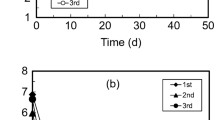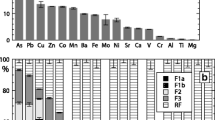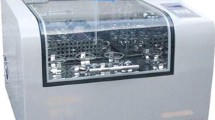Abstract
Biological solubilization of metals in highly contaminated sediments (Lachine Canal, Montreal, P.Q., Canada) was tested in 500 mL batches. The biological process uses the leaching capacity of Thiobacilli. Batch experiments were performed to determine the influence of initial pH, the percentage of inoculum, and the addition of nitrogen and phosphate on the efficiency of the process. Similar metal recoveries were obtained at either of the initial pH values (pH 4.0 and pH 4.5). The addition of 20% inoculum (v/v) appears to result in acceptable yields over a short time period (24–48 hours). Solubilization of Cu is strongly correlated with the presence of bacteria (r2 increase with time up to 0.90 after 53h). In the case of Zn (within first 6 hours) and Pb (at the beginning), the chemical environment appears to be the main factor controlling solubilization of these elements (r2 up to 0.99). The addition of nutrients had no affect on the production of Thiobacilli, but the addition of NH4 reduced the solubilization of Zn, Pb (r2 up to 0.90) and at the beginning, the solubilization of Cu (r2=0.67). While the addition of PO4 3- diminished the solubilization of Zn, Pb and Cu (r2 up to 0.96). Upon addition of substrate (FeSO 4.7H2), the growth of Thiobacilli already present in the sediments is favored. The application of this process to sediments appears feasible, as Zn and Cu levels were at acceptable levels following treatment. Further studies are necessary to improve the removal of Pb.
Similar content being viewed by others
References
Anonymous (1986). Methods of Soil Analysis-Physical and Mineralogical Methods, Second Edition. In: Methods of Soil Analysis, part 1. American Society of Agronomic Inc. Soil Science Society of America Inc., Eds Arnold Klute. p. 404.
APHA (1985). Standards Methods for the Examination of Water and Wastewater, 16th edition. American Public Health Association, Washington, D.C.
Antoun, H.: 1986, Science du sol. Faculté des sciences de l'agriculture et de l';alimentation. Département des sols, Université Laval, p. 5-5 - 5-9.
Bastille C., St-Pierre S. et Dubreuil B.: 1989, Manuel des méthodes de laboratoire, juin 1989, INRS-Eau, 2700 rue Einstein, Sainte-Foy, (Qc). G1P 3W, p. 284.
Blais, J. F., Tyagi, R. D., Auclair, J. C. and Huang C. P.: 1992, Wat. Sci. Tech. 26(1-2), 197-206.
Brierley C. L.: 1982, ‘Microbiological Mining’, Sc. American 247: 44-53.
Brierley C. L.: 1978, Bacterial leaching. CRC Critical Reviews in Microbiology 6, pp. 207-262.
Bosecker K. and Kürsten M.: 1978, Process Biochemestry 13(2), 2-4.
Campbell, P. G. C., Lewis, A. G., Chapman, P. M., Crowder, A. A., Fletcher, N. K., Imber, B., Luoma, S. N., Stokes, P. M. and Winfrey, M.: 1988, ‘Biological Available Metals in Sediments’, In: National Research Council of Canada, NRCC27694, p. 298.
Chartier, M.: 1993, Développement d'un procédé pour l'enlèvement des métaux lourds dans les sédiments, Mémoire de maîtrise, INRS-Eau, Université du Québec, Sainte-Foy, Québec, 550 p.
Couillard, D.: 1982, Can. J. Earth Sci. 19(7), 1492-1506.
Couillard, D.: 1980, Can. Wat. Resour. J. 5(4), 55-81.
Couillard, D. and Chartier, M.: 1994, Revue des Sciences de l'eau 7, 251-268.
Couillard, D. and Mercier, G.: 1993, Wat. Res. 27(7), 1227-1236.
Couillard, D., Chartier, M. et Mercier, G.: 1992, Optimisation de la solubilisation biologique des métaux lourds dans les boues aérobies en mode cuvée. Rapport scientifique no 348, INRS-Eau, Université du Québec, pp. 212.
Couillard, D., Chartier, M. and Mercier, G.: (1991a), Bioresour. Technol. 36, 293-302.
Couillard, D., Chartier, M. and Mercier, G.: (1991b), Envir. Technol. Lett. 12, 1095-1105.
Couillard, D. and Mercier, G.: 1991, Wat. Res. 25, 211-218.
Couillard, D. and Chartier, M.: 1991, J. of Biotechnol. 20, 163-180.
Couillard, D. and Mercier, G.: 1990a, Envir. Pollut. 66: 237-252.
Couillard, D. and Mercier, G.: 1990b, Can. J. Chem. Engrs. 69, 779-787.
Couillard, D., Mercier, G. and Tyagi, R.D.: 1988, Problématique des métaux lourds dans les boues résiduaires et revue de littérature sur les méthodes d'enlèvement de ces métaux, Rapport scientifique no 262, INRS-Eau, Université du Québec, pp. 267.
Dugan, P.R. and Apel, W. A.: 1978, ‘Microbiological Desulfurization of Coal’, In: Metall. Application of Bacterial Leaching and Related Microbiological Phenomena, Eds Academic press, New York. pp. 223-250.
Environnement Canada: 1978, Plan d'utilisation des matériaux dragués dans le fleuve St-Laurent, Annexe no 6, Rapport soumis au comité d'étude sur le fleuve St-Laurent par la direction générale des eaux intérieures, p. 173.
Guay, R., Silver, M. and Torma, A.E.: 1976, European J. Appl. Microbiol. 3, 157-167.
Guay, R., Torma, A. E. and Silver, M.: 1975, Annales de Microbiologie 126B, 209-219.
Ingledew, J. W.: 1982, Biochimica et Biophysica Acta 683, 89-117.
Kelly, D. P.: 1982, Biochemestry of the Chemolithotropic Oxydation of Organic Sulphur', In: Philosophy Trans Royal Soc. of London B298, 499-528.
Lacey, D. T. and Lawson, F.: 1970, Biotechnol. Bioeng. 12, 29.
Leving: 1982, The Ecological Consequences of Dredging and Dredge Spoil Disposal in Canadian Waters. NRCC #18130, p. 140.
Ludwig, D. D., Sherrard, J. H. and Amende, R.A.: 1989, J. Wat. Pollut. Contr. Fed. 61(11/12), 1666-1672.
Lundgren, D. G. and Silver, M.: 1980, Ann. Rev. Microbiol. 34, 263-283.
Luoma, S. N.: 1989, Hydrobiol. 176/177, 379-396.
McCready, R. G. L., Wadden, D. and Marchbank, A.: 1986, Hydrometallurgy 17, 61-71.
Mercier, G.: 1988, L';extraction biologique des métaux lourds des boues anaérobies d'épuration, Mémoire de maîtrise, INRS-Eau, Université du Québec, Ste-Foy, Québec, p. 285.
Murr, L. E.: 1982, Biotech. and Bioengng, XXIV, 743-748.
Piché, I.: 1989, Recherche d'un substrat économique pour la solubilisation des métaux lourds dans les boues résiduaires, Mémoire de maîtrise, INRS-Eau, Université du Québec, Ste-Foy, Québec, p. 179.
Schecher, W.D. and McAvoy, D. C.: 1991, MINEQL+: A Chemical Equilibrum Program for Personal Computers. Environmental Research Software, version 2.1, p. 90.
Shea, D.: 1988, Envir. Sci. Technol. 22(11), 1256-1261.
Smith, J. R., Luthy, R. G. and Middleton, A.C.: 1988, Journal WPCF 60, 518-530.
Torma, A. E.: 1986, Biohydrometallurgy as an Emerging Technology. Biotechnology and Bioengineering Symposium, No. 16: 49-63.
Torma, A. E., Walden, C. C., Duncan, D. W. and Branion, R. M. R.: 1972, Biotechnology and Bioengineering 14, 777-786.
Torma, A. E., Walden, C. C. and Branion, R. M. R.: 1970, Biotechnology and Bioengineering 12, 501-517.
Wong, L. and Henry, J. G.: 1984, Water Science and Technology 17, 575-586.
Author information
Authors and Affiliations
Rights and permissions
About this article
Cite this article
CHARTIER, M., COUILLARD, D. BIOLOGICAL PROCESSES: THE EFFECTS OF INITIAL pH, PERCENTAGE INOCULUM AND NUTRIENT ENRICHMENT ON THE SOLUBILIZATION OF SEDIMENT BOUND METALS. Water, Air, & Soil Pollution 96, 249–267 (1997). https://doi.org/10.1023/A:1026472821060
Issue Date:
DOI: https://doi.org/10.1023/A:1026472821060




